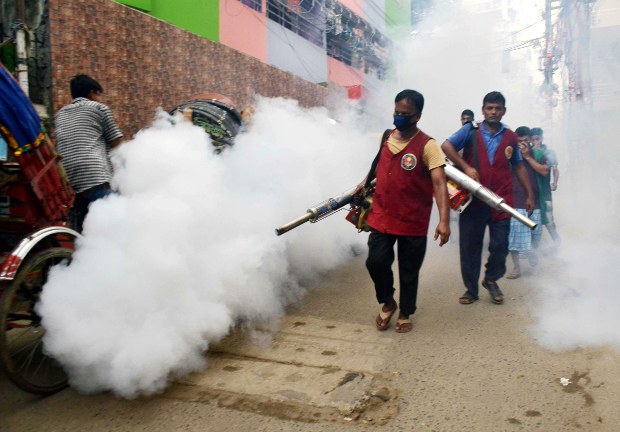Chikungunya Outbreak Spreads Beyond Bangladeshi Capital: Health Officials
2017.07.21
Dhaka
 Workers with the South Dhaka City Corporation fumigate streets to control the spread of mosquitoes, July 14, 2017.
Workers with the South Dhaka City Corporation fumigate streets to control the spread of mosquitoes, July 14, 2017.
A mosquito-borne disease that broke out in Dhaka in April has spread to at least four more districts of Bangladesh with hundreds of confirmed cases, raising fears among health practitioners of a possible epidemic.
The disease, Chikungunya, is rarely fatal and has not caused any deaths in the Bangladeshi capital, but health officials have confirmed 737 cases between April and July 19, according to Dr. Meerjady Sabrina Flora, director of the Institute of Epidemiological, Disease Control and Research (IEDCR) at the Ministry of Health.
New cases could be reported between now and September, the last month of the rainy season, when mosquitos breed in stagnant waters caused by heavy rains, Flora said.
“So far we have confirmed 737 cases of chikungunya,” Flora told BenarNews. “We’ve got patients from four more districts – Gazipur, Narshingdi, Gopalganj and Bogra.”
Chikungunya (pronounced: chik-un-GUN-yuh) is a viral disease transmitted to humans by mosquitoes. It causes the sudden onset of fever and severe joint pain, headache, nausea, fatigue and rash, according to the World Health Organization (WHO).
The disease mostly occurs in Africa, Asia and the Indian subcontinent, but it has been identified in more than 60 countries, WHO said.
The name for the virus comes from a word in Kimakonde, the language spoken by an ethnic group in Tanzania, where Chikungunya was first detected in 1952. It means “to become contorted” and describes the stooped appearance of sufferers with joint pain, Geneva-based WHO said.
Although there have been no reports of fatalities from chikungunya in Bangladesh, the health ministry has received about 4,700 blood samples of patients with symptoms at hospitals and clinics across the country, Flora said.
No vaccines, no cure
The disease shares some clinical signs with two other mosquito-borne viruses, dengue and zika, and can be misdiagnosed in areas where they are common, health officials said.
There are no vaccines to prevent the chikungunya virus, and there is no cure. However, the disease runs a limited course. Signs and symptoms of chikungunya usually appear two to seven days after being bitten by an infected mosquito, usually the aedes aegypti.
A.B. Siddique, a physician and former public analyst at the Institute of Public Health, warned that chikungunya may continue to spread rapidly as more and more people visit Dhaka.
“Thousands of people visit the capital every day because Dhaka is the center of economic and other activities in Bangladesh,” he said. “So, unless necessary preventive measures are adopted, chikungunya may cause an epidemic.”
The only way to eradicate the disease is to destroy the mosquito and its habitat, officials said.
Gazipur and Narshingdi districts are adjacent to Dhaka, but the virus has reached southwestern Gopalganj and northwestern Bogra districts, potentially delivering a huge impact on health services, according to officials.
Dhaka Medical College Hospital, Bangladesh’s premier hospital, faces the biggest pressure as hundreds of patients have been coming to the hospital daily for treatment of various ailments, according to Saiful Islam, a medical officer at the DMCH.
He said he recently saw several families with more than one member stricken by the virus.
“My wife and I had chikungunya at the same time. Now, many of my friends and relatives (in Dhaka) have been suffering from chikungunya,” Dr. Farid Uddin Ahmed, a resident of Dhaka's Mirpur neighborhood, told BenarNews.
He said he could not walk for more than a month after his recovery.
“Go to any part of Dhaka, you will get chikungunya patients of all ages. If the authorities fail to eliminate Aedes mosquitoes, chikungunya situation may become an epidemic,” he said.
Dr. Shafiul Akram, a physician practicing at a private clinic in Mirpur Dhaka, told BenarNews that he, too, had been stricken by the virus.
“Even three weeks after I recovered from chikungunya, I cannot stand when I sit,” he said. “At our clinic, we get a huge number of people coming for the chikungunya test.”
Zahid Malek, the state minister for Health and Family Welfare, acknowledged that chikungunya was becoming a “health problem,” but said it had not reached epidemic levels.
The government has been working with WHO and other agencies to fight the spread of the virus by conducting awareness campaigns, he said.
“It is not possible for the government to clean the homes of the people,” Malek said. “The residents will have to shoulder the responsibility to eradicate the Aedes mosquito in their neighborhoods.”
The WHO office in Dhaka did not respond to a BenarNews request for comment.







